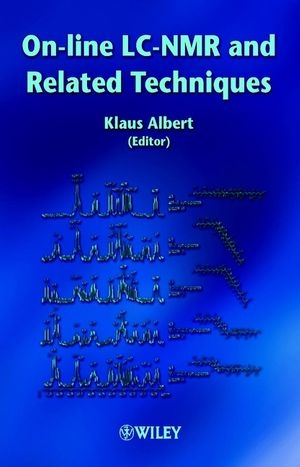
On-line LC-NMR and Related Techniques
John Wiley & Sons Inc (Verlag)
978-0-471-49649-6 (ISBN)
- Titel z.Zt. nicht lieferbar
- Versandkostenfrei
- Auch auf Rechnung
- Artikel merken
This book gives a comprehensive overview of the basis and the current applications of LC-NMR and related techniques. It deals with the practical aspects of the hardware and software set-up for a successful performance of on-line coupling experiments. It covers the solution of real-word problems from the fields of biomedical, pharmaceutical and environmental studies as well as the analysis of natural products and polymeric compounds. Thus guidelines for an efficient application of the powerful hyphenated technique LC-NMR in combination with LC-MS are presented. Besides LC-NMR, important techniques such as the on-line coupling of gel permeation chromatography and supercritical fluid chromatography, together with 1H NMR spectroscopy, are described in detail.
Fascinating further aspects, such as the application of capillary separation techniques either in the single or parallel detection mode, together with the possibilities of direct 13C monitoring of chromatographic events, are also discussed.
Key features include:
* Up-to-date information on the theoretical and experimental methodology
* Coverage of applications in biomedical, pharmaceutical and natural product analysis, as well as environmental polymer and related hyphenated techniques
* Information appropriate for researchers in organic, pharmaceutical and medical chemistry
Overall, this book is a requirement for all researchers and staff members dealing with structure elucidation problems in separation science.
Klaus Albert is the editor of On-line LC-NMR and Related Techniques, published by Wiley.
Contributors.
Preface.
1. LC-NMR: Theory and Experiment (Klaus Albert).
1.1 Introduction.
1.2 NMR in a Flowing Liquid.
1.3 Design of Continuous-Flow NMR Probes.
1.4 Experimental Arrangement for HPLC-1H NMR Coupling.
1.5 Practical Considerations, Solvent Suppression Techniques, Gradient Elution and Purity of HPLC Solvent.
References.
2. LC-NMR: Automation (Ulrich Braumann and Manfred Spraul).
2.1 Practical Use of LC-NMR and LC-NMR/MS.
2.2 Different Working Modes in LC-NMR.
2.3 Use of Mass Spectrometry in the Set-Up.
2.4 Measurement Procedures.
2.5 Conclusions.
References.
3. Biomedical and Pharmaceutical Applications of HPLC-NMR and HPLC-NMR-MS (John C. Lindon, Jeremy K. Nicholson and Ian D. Wilson).
3.1 Introduction.
3.2 Technical and Operational Overview.
3.3 Applications in Combinatorial Chemistry.
3.4 Application to Chemical Impurities.
3.5 Application to Chiral Separations of Pharmaceutical Mixtures.
3.6 Application to Natural Products.
3.7 Application to Chemical Reactivity of Drug Glucuronides.
3.8 Application to Futile Deacetylation Reactions.
3.9 Application to Trapping of Reactive Intermediates.
3.10 Application to Uptake and Transformation of Xenobiotics by Plants.
3.11 Separation of Lipoproteins and their Characterisation using HPLC-NMR.
3.12 Superheated-Water HPLC-NMR and HPLC-NMR-MS Studies on Pharmaceuticals.
3.13 Application of Hypernation to a Mixture of Non-Steroidal Anti-Inflammatory Drugs.
3.14 Concluding Remarks.
References.
4. Application of On-Line LC-NMR and Related Techniques to Drug Metabolism Studies (John P. Shockcor).
4.1 Introduction.
4.2 LC-NMR Techniques.
4.3 Application of LC-NMR-MS to Drug Metabolism: The Structure Elucidation of Rat Urinary Metabolites of Efavirenz by LC-NMR-MS.
References.
5. LC-NMR for Natural Products Analysis.
5.1 Application of LC-NMR and LC-NMR-MS Hyphenation to Natural Products Analysis (Martin Sandvoss).
References.
5.2 Hyphenation of Modern Extraction Techniques to LC-NMR for the Analysis of Geometrical Carotenoid Isomers in Functional Food and Biological Tissues (Tobias Glaser and Klaus Albert).
References.
6. LC-NMR in Environmental Analysis (Alfred Preiss and Markus Godejohann).
6.1 Introduction.
6.2 Target and Non-Target Analysis.
6.3 LC-NMR Coupling in Non-Target Analysis.
6.4 Application of LC-NMR and LC-NMR in Combination with LC-MS to Environmental Samples.
6.5 Simulation of Environmental Processes.
6.6 Conclusions.
References.
7. Related Techniques -
Introduction.
7.1 GPC-NMR Coupling (Heidrun Händel and Klaus Albert).
References.
7.2 SFC-NMR and SFE-NMR (Holger Fischer and Klaus Albert).
7.3 Nanoliter NMR.
8. Future Developments -
Introduction
8.1 HPLC-13C NMR (Klaus Albert).
8.2 Parallel NMR Detection (Andrew G. Webb, Jonathan V. Sweedler and Daniel Raftery).
Concluding Remarks (Klaus Albert).
Index.
| Erscheint lt. Verlag | 29.7.2002 |
|---|---|
| Verlagsort | New York |
| Sprache | englisch |
| Maße | 155 x 236 mm |
| Gewicht | 567 g |
| Themenwelt | Naturwissenschaften ► Chemie ► Analytische Chemie |
| ISBN-10 | 0-471-49649-9 / 0471496499 |
| ISBN-13 | 978-0-471-49649-6 / 9780471496496 |
| Zustand | Neuware |
| Haben Sie eine Frage zum Produkt? |
aus dem Bereich


